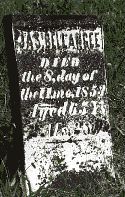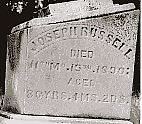



Quakers, or members of the Society of Friends, are a sect of Christians who believe that an "Inner Light" within each individual is a divine revelation. As such, the Quakers have no ordained ministers, rather members of the congregation may speak as they are moved to do so. However, local congregations may recognize that an individual has a particular gift for speaking and acknowledge this to other congregations. In such a way, several individuals have become renowned Quaker "missionaries" and have traveled through many areas to share their gifts. Of utmost importance to Quakers is their lifestyle, and the local congregations are responsible for disciplining members for straying from the accepted way of life. The "rules" of the Quakers may seem quite strict. They were not allowed to attend dances, drink liquor, marry non-Quakers, marry without prior approval, or live in luxurious ways.
Regardless of the Quaker belief that religious direction comes from within the individual, the hierarchy of the Quaker religion was quite extensive and quite organized. Those who are tracking their ancestral lines may find a bit of assistance if one of their ancestors was a Quaker. Quakers are known for the extensive written records of births, marriages, and deaths of members dating to the 1600s. In addition, upon moving from a locality, the Quaker was issued a letter of transfer to the next meeting, so often, the previous residence or the future residence is listed in the records. The genealogical information in many of these records have been extracted & published [2].
Quaker settlements were prominent in the early days of Pennsylvania, Rhode Island, and New Jersey. The Carolinas also provided homes for Quakers. The Philadelphia area is particularly rich in Quaker history. As the American Westward expansion took place, the Quaker religion also moved westward into Ohio and beyond. A large Quaker settlement was located in eastern Ohio, in the counties of Belmont and Jefferson. Westward expansion continued into Indiana and Illinois.
Southwest Fulton County, particularly Pleasant, Bernadotte, Vermont and Farmers Twp., was the home of Quakers. Short references to the Quakers are found in the county histories, with more extensive discussions in "A History of Ipava"[3]. Other information comes from a diary entitled "Journal and Essays on Religious Subjects" written by James BELLANGEE [4].
Quaker influences in Fulton County probably began with the arrival of the BOGUE families from eastern Ohio in 1829. By about 1832, the BOGUES were closely followed by the EASLEYs, the KNOCKs, the CHICKENs and the GREWELLs. Other Quakers joined the community throughout the 1830s and the 1840s. These families included the ROBINSONs, the MARSHALLs, the DAVIDs, the CADWALLADERs. James BELLANGEE states in his diary that upon deciding to move to Fulton County, Illinois, a few Quakers were already living there. He & his family took a steamboat from Wheeling (now in W. Virginia) to St. Louis. They took another boat to Spark's Landing [5], arriving in 1839. This trip was not unlike the one taken by the EASLEYs from Ohio to Fulton County nearly ten years earlier. The influx of Quakers into Fulton County continued into the 1850s.
The large number of Quakers suggests that the community might have been gathering for worship from the first arrivals in 1829. In fact, James BELLANGEE says that by mid-1840, the group had been meeting weekly for a full year. The first meetings in Fulton County were held in existing buildings, probably the homes of the Quakers. Phebe EASLEY FITZHENRY recalled a meeting held in her families' cabin held in 1843 [6]. Eventually, a meeting house was built southwest of Ipava, in Vermont Township, near the center of Section 14.
According to James BELLANGEE, the first house was built around 1840. The records of Clear Creek Monthly Meeting [7] show a deed for land in Fulton County on May 1, 1840 from Isaac and Elizabeth CADWALLADER to James BELLANGEE, Thomas SIDWELL, and Rhodes DILLWORTH of the Religious Society of Friends [8]. This deed may be for the site of the meeting house. However, no officially sanctioned business Meeting [9] was held until 1848. Another deed for the transfer of the land to the Society of Friends was recorded in Fulton County on January 16, 1850. The prior owners of the lot were James A. and Elizabeth M. RUSSELL, prominent members of the Society. The trustees of the Society who were listed on the deed were Joseph I. RUSSELL, Joseph BEANS, and Joseph LOWNES. I am not certain what land this represents.
The group in Fulton County became known as the Plainfield Meeting. It was a "Hicksite" group, and many of its members had been Hicksite Quakers for several years. The Hicksites were a branch of the Quakers named for their "leader" Elias Hicks. The division of the Society occurred in 1828, when a large disturbance occurred near Mt. Pleasant, Ohio. The Hicksites desired to maintain the individuality in worship, being guided by the "Inner Light", while the Orthodox Quakers preferred to place ministers and elders in positions of authority.
In mid-1841, according to James BELLANGEE, the group was content, but a year later, he reported some problems. BELLANGEE suggests that much of the discontent was brought about by a Quaker who taught school for one quarter in the neighborhood. It appears that this man was followed by some unfavorable references, and it seems that he was a bit too light-hearted for BELLANGEE's taste. BELLANGEE also reports that although the group had increased in size, there were not many active members.
During this time, a suitable place for the Quaker cemetery was chosen about a quarter to half of a mile west of the meeting-house. James RUSSELL was the first one buried there. In accordance with the simplicity of Quaker life, many of the stones in the cemetery are small, with few identifying features. In some eras, no name or date was placed on the stone. It is likely that several now unmarked graves are located in this cemetery. Many of the stones bear inscriptions such as "Susan, wife of James Russell, died the 25th day of the 3rd month 1856. . . ."[10] The Quakers used the number of the month as opposed to the names (e.g. April). This Quaker influence can be seen in other cemeteries in Fulton County (e.g. Easley Cemetery in Sec 27, Vermont Twp.)
By 1843, BELLANGEE's journal reports that more dissent had occured. The man who did not conform to BELLANGEE's (& apparently others') ideals continued to speak in the meetings. The man had the support of his family in the area, and after continued dissention, the man, his family & some others separated themselves from the rest of the local Society. Deaths, emigration, and lack of new members dropped the membership.
Toward the end of 1844, BELLANGEE reports that the other group had dropped their meeting and that the initiator of the trouble had returned to Indiana. The group in Fulton County first requested the establishment of a Meeting for worship, as well as a preparative and a monthly Meeting to be known as Plainfield in June 1847. This request was made to the closest organized meeting, the Clear Creek Monthly Meeting in Putnam County, Illinois, nearly 100 miles away north on the Illinois River. Final approval of the Plainfield Meeting came in May 1848, and the Meeting was officially opened in Oct. 1848.
Sometime in 1849, dissention again arose within the group at Plainfield. It appears that an attempt to discipline one of the members was made, but without support of many members. This disagreement continued and grew, but the members finally agreed to drop the charge and erase it from their minutes.
In 1850, the Plainfield Meeting joined with the Clear Creek Meeting in requesting that a Quarterly Meeting to be held alternately at the two sites be approved by the Indiana Yearly Meeting, to which both were subject. This request was denied.
In 1851, BELLANGEE reports that the Fulton County Peace Society was held in Friends meeting-house at Plainfield. He reports:
We meet without any distinction of sects, to bear our testimony against war and sectarianism, but in favor of peace and Christianity. Our meeting was held to the satisfaction of those who attended it; though it was small on account of the cholera prevailing in Vermont, and the extremely wet and muddy roads and high waters. This meeting is intended for all societies or persons, of whatsoever sect or name, that we may all meet together with one accord and in one place, to mingle in this most noble testimony against war; all having a free and full exercise of that reason which God has given us, and of the light with which Christ has enlight ened our minds, and let it so shine towards each other, to the comforting of those whose spirits breathe peace on earth and good will to men.
In Feb. 1854, about five years after its initiation, the Meeting at Plainfield was officially disbanded or "laid down." The members of the Plainfield Meeting then became members of the Clear Creek Meeting. The Plainfield property was sold in 1893. The county histories report that many of those raised within the Society of Friends became members of other Christian denominations. The records of the Clear Creek Monthly Meeting show that many of the Fulton County Quakers maintained contact with the Society, even into the 20th century.
The written records of the Plainfield Meeting are in the Friends Historical Library of Swarthmore College, Swarthmore, PA. The genealogical information in the records have been abstracted [11]. Some information about the members at Plainfield can also be found in the records of the Clear Creek Meeting [12].
Some obvious names which are missing from this list of the members of the Plainfield Meeting include the BOGUEs and the CADWALLADERs. The BOGUEs had been members of the several Quaker meetings in Ohio. Jonathan BOGUE died in 1820, and his wife Sarah (EASLEY) came to Fulton County with their children Mary Ann, Ruth, Mark, and John BOGUE. Job BOGUE & Mary Ann (EASLEY) and their children were other early arrivals in Fulton County. Members of both families were granted transfers from their previous Monthly Meetings to the Vermillion Monthly Meeting in east central Illinois in 1839. Also in 1839, transfers to Vermillion Monthly Meeting were granted to John & Ruth CADWALLADER and their children Ruth, John, Sabina, Mary (Margaret), & Jesse Kersey. Others who are obviously missing from the abstracts of the written records of Plainfield are the EASLEYs and the GREWELLs.


